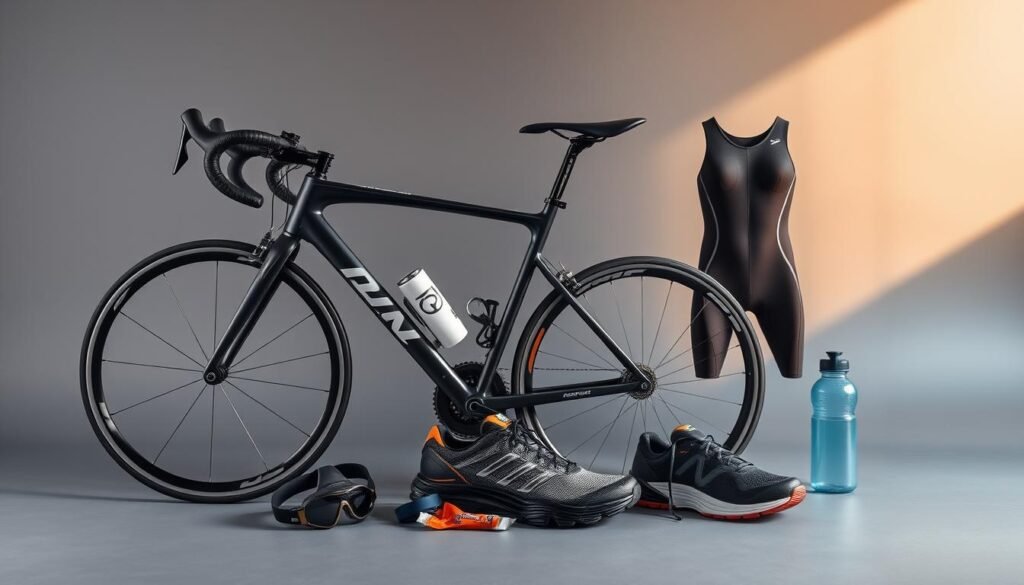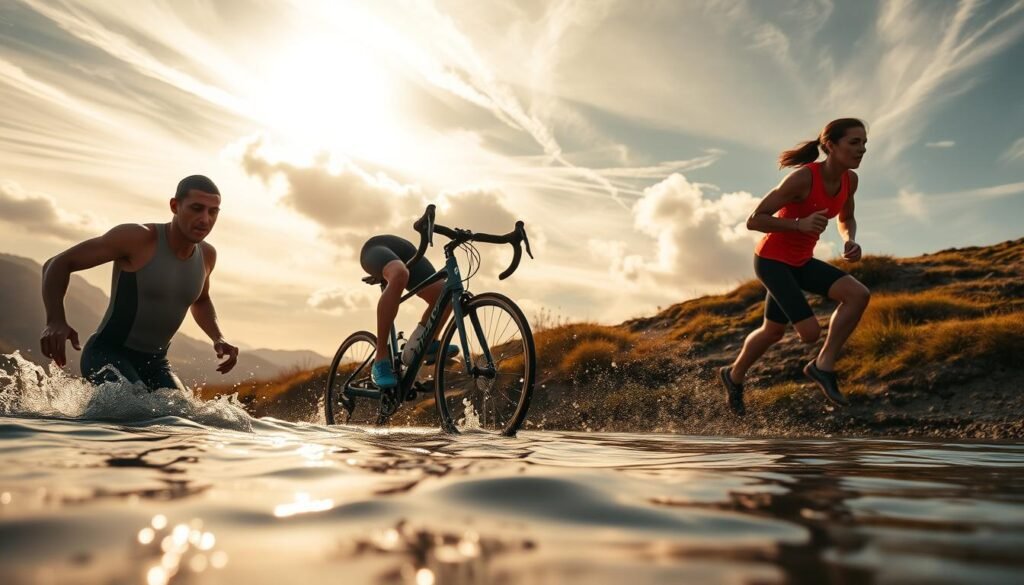Ever thought a triathlon was only for elite athletes? Think again. Whether you’re recovering from an injury, just starting your fitness journey, or looking for a new challenge, this multi-sport event is more accessible than you might believe.
From teenagers to competitors over 50, people of all ages and fitness levels cross finish lines every year. With the right plan, even four to five hours of training per week can prepare you for a sprint-distance race.
Ditch the myth that you need expensive gear or superhuman endurance. Many first-time participants complete their races with basic equipment and sheer determination. The key lies in structured workouts, gradual progression, and a mindset focused on personal goals.
Key Takeaways
- Triathlons welcome all ages, body types, and fitness backgrounds.
- Beginners can succeed with just 4-5 hours of weekly training.
- Expensive equipment isn’t necessary—focus on consistency instead.
- Structured sessions for swim, bike, and run build endurance safely.
- Events like the Ironman World Championship inspire newcomers.
Understanding Triathlon Distances: From Sprint to Ironman
The world of triathlon offers distances for every fitness level and ambition. Whether you crave a quick challenge or a legendary test of endurance, there’s a race format to match. Events range from beginner-friendly sprints to the iconic Ironman, each with unique demands.
Standard Race Formats and Their Requirements
Triathlons follow set distances for swimming, cycling, and running. Here’s what to expect:
- Sprint: 750m swim, 20km bike, 5km run (8-week training).
- Olympic: 1.5km swim, 40km bike, 10km run.
- Half-Iron: 1.9km swim, 90km bike, 21.1km run.
- Ironman: 3.8km swim, 180km bike, 42.2km run (6+ months prep).
Shorter races focus on speed, while longer ones demand endurance and meticulous planning.
Why Beginners Should Start With a Sprint Triathlon
Newcomers gain the most from sprint triathlon events. These races minimize injury risk while teaching essential skills. A Nike coach notes: “Shorter distances let you master transitions.”
Other advantages include:
- Lower costs: Basic gear under $600 vs. Ironman-specific equipment.
- Time efficiency: Fewer weekly sessions fit busy schedules.
- Progressive goals: Build confidence before tackling longer races.
Organizations like Supertri emphasize short-course accessibility, making sprints the ideal starting point.
How to Choose Your First Triathlon Race
Beginner-friendly triathlon events prioritize accessibility and community support. The right race balances challenge and enjoyment, setting you up for success. Consider terrain, logistics, and inclusivity when making your pick.
Factors to Consider: Location, Terrain, and Community
Flat courses reduce strain on your bike and running legs, ideal for newcomers. Hilly routes demand more training but offer scenic rewards. Urban events, like the Chicago Triathlon, simplify travel and spectator access.
Look for these features:
- Proximity: Shorter travel means less pre-race stress.
- Inclusivity: Women’s-only or adaptive athlete divisions foster support.
- Amenities: Post-day perks like massages aid recovery.
Resources for Finding Beginner-Friendly Events
Platforms like TriFind.com filter races by difficulty and location. Supertri’s urban series focuses on central venues, eliminating rural logistics. For curated picks, explore Triathlete’s 12 Best Beginner Races in the U.S.
Building Your 12-Week Triathlon Training Plan
A solid 12-week training plan transforms beginners into confident triathletes. By dividing prep into phases, you’ll build endurance safely and avoid burnout. Nike’s framework recommends 6–8 hours weekly, blending swim, bike, and run sessions with strategic recovery.
Phase 1: Establishing a Base (Weeks 1–4)
Focus on low-intensity workouts to condition your body. Swim 2–3 times weekly for 20–30 minutes, mixing drills and steady laps. On the bike, practice cadence drills at 80–90 RPM. For the run, alternate walking and jogging intervals.
Recovery days are critical. Supertri advises light yoga or stretching to prevent injury.
Phase 2: Increasing Endurance (Weeks 5–8)
Add hill climbs to cycling sessions and try open-water swims. Introduce 30-minute brick workouts—cycling followed immediately by a short run. These mimic race conditions and boost stamina.
Every other week, schedule a long ride or run to test progress.
Phase 3: Race-Specific Prep (Weeks 9–12)
Simulate race pace in all disciplines. Rehearse the full sprint distance once, then taper workouts by 40–50% in the final week. This reduces fatigue while maintaining fitness.
Pack your gear early and practice transitions to save time on race day.
Essential Gear for Your First Triathlon
Smart gear choices can make or break your race-day experience. Focus on lightweight, functional items that suit your budget and discipline. Beginners often spend less than $600 on essentials, according to Triathlete.

Swim Gear: Wetsuits vs. Swimsuits
Open-water swims may require a wetsuit for buoyancy and warmth. In warmer pools, a flexible swimsuit works better. Goggles with anti-fog coating are non-negotiable.
Save costs by renting a wetsuit or using gym pool access for training. Brands like Roka offer affordable options for beginners.
Bike Essentials: From Road Bikes to Safety Checks
Any roadworthy bike suffices—even borrowed ones. Prioritize safety with these checks:
- Brakes: Test responsiveness before every ride.
- Tire pressure: Adjust based on terrain.
- Chain lubrication: Prevents mid-race malfunctions.
A helmet is mandatory. Consider padded shorts for comfort during long training sessions.
Running Shoes: How to Pick the Right Pair
Choose shoes based on foot type to avoid injury. Brooks suits high arches, while Asics provides stability for flat feet. Break them in during training weeks.
Replace shoes every 300–500 miles. Pair with moisture-wicking socks to prevent blisters on race day.
Triathlon Nutrition: Fueling for Training and Race Day
Fueling your body correctly can be the difference between success and hitting the wall. Proper nutrition supports endurance, recovery, and performance across all three disciplines. Whether you’re logging training miles or competing, smart eating habits keep energy steady.
Daily Meal Planning for Endurance Athletes
Balance carbs, protein, and fats to sustain intensity. Nike recommends 50–120g of carbs per hour during long workouts. Post-session, aim for a 4:1 (men) or 1.5:1 (women) carb-to-protein ratio to rebuild muscles.
Sample meals for athletes:
- Breakfast: Oatmeal with eggs for slow-release energy.
- Lunch: Grilled chicken and quinoa for lean protein and fiber.
- Snacks: Greek yogurt or bananas to curb hunger.
Race-Day Fueling Strategies to Avoid Bonking
Start with a light, low-fiber breakfast 2–3 hours before the race. UCAN energy gels provide steady blood sugar without spikes. Sports dietitian Susan Kitchen advises: “Practice fueling during long bricks to test tolerance.”
Avoid these mistakes:
- High-fiber pre-day meals that cause discomfort.
- Skipping electrolytes, leading to cramps.
- Waiting until thirsty to hydrate.
Weigh yourself pre- and post-workouts to calculate fluid loss. Replace every pound lost with 16–20oz of water.
Mastering Key Skills Before Race Day
Success in a triathlon hinges on mastering specific techniques before the big day. While endurance matters, refined skills help conserve energy and prevent mishaps. Focus on these three areas during your final training weeks.

Open-Water Swimming Techniques
Pool laps differ drastically from open-water conditions. Practice bilateral breathing to adapt to waves and sunlight glare. Draft behind other swimmers during sessions to conserve 20% energy, as Triathlete research confirms.
Mass start simulations prepare you for crowded conditions. Swim parallel to shore while lifting your head every 6-8 strokes to sight landmarks. Supertri clinics recommend practicing in wetsuits if your race requires them.
Brick Workouts: Bike-to-Run Transitions
The brick workout bridges cycling and running disciplines effectively. Start with a 45-minute ride at Zone 2 intensity, then immediately transition to a 15-minute run. This conditions legs for the jarring shift between sports.
Focus on quick gear changes in your training area. Lay out equipment in the exact order needed on race day. Time yourself to identify areas for improvement between sessions.
Handling Gear Malfunctions
Even with perfect preparation, equipment fails. Master the 6-step flat tire fix using CO2 cartridges—practice until you can complete it under 5 minutes. Always carry spare tubes and tire levers during bike workouts.
Test gear in rainy or windy conditions before the event. The Triathlete Illustrated Guide to Racing demonstrates emergency fixes for chain drops and slipped derailleurs. Knowing these skills prevents panic when problems arise.
Conclusion: Crossing Your First Finish Line
Crossing the finish line transforms beginners into triathletes. Remember three keys: start with sprint distances, refine technique, and tap into communities like Triathlete’s 1.4M-strong Instagram. Every step builds toward race day.
Download our free 12-week training plan PDF to structure your prep. Share your journey—tag @triathletemag in finish-line photos. Supertri’s 2024 calendar features beginner-friendly races, perfect for first-timers.
As pro athletes say: “The pain is temporary—the pride is forever.” Your starting line awaits.
FAQ
What’s the best triathlon distance for beginners?
Sprint triathlons are ideal for newcomers. They feature shorter distances—typically a 750m swim, 20km bike, and 5km run—making them manageable while still challenging.
How often should I train each week?
Aim for 4-6 weekly sessions, balancing swim, bike, and run workouts. Include at least one rest day to prevent injury and allow recovery.
Do I need a wetsuit for the swim?
It depends on water temperature. Wetsuits provide buoyancy and warmth in cold water but aren’t mandatory for warmer conditions. Check race rules for requirements.
What’s a brick workout?
A brick session combines cycling followed immediately by running. This helps your body adapt to the transition between disciplines, a key part of race day.
How do I prevent fatigue during the race?
Practice nutrition strategies in training. Consume easily digestible carbs like energy gels or bananas during longer sessions to maintain energy levels.
Can I use a mountain bike for my first race?
Yes, but road or tri bikes are faster. If using a mountain bike, ensure it’s tuned up and consider slick tires for better efficiency on pavement.
How important are transitions?
Transitions can save valuable time. Rehearse setting up your gear and switching between swim-bike-run to streamline your race-day process.
Should I hire a coach?
A coach provides structure and accountability, but many beginners succeed with self-guided plans. Online programs like TrainingPeaks offer customizable options.



